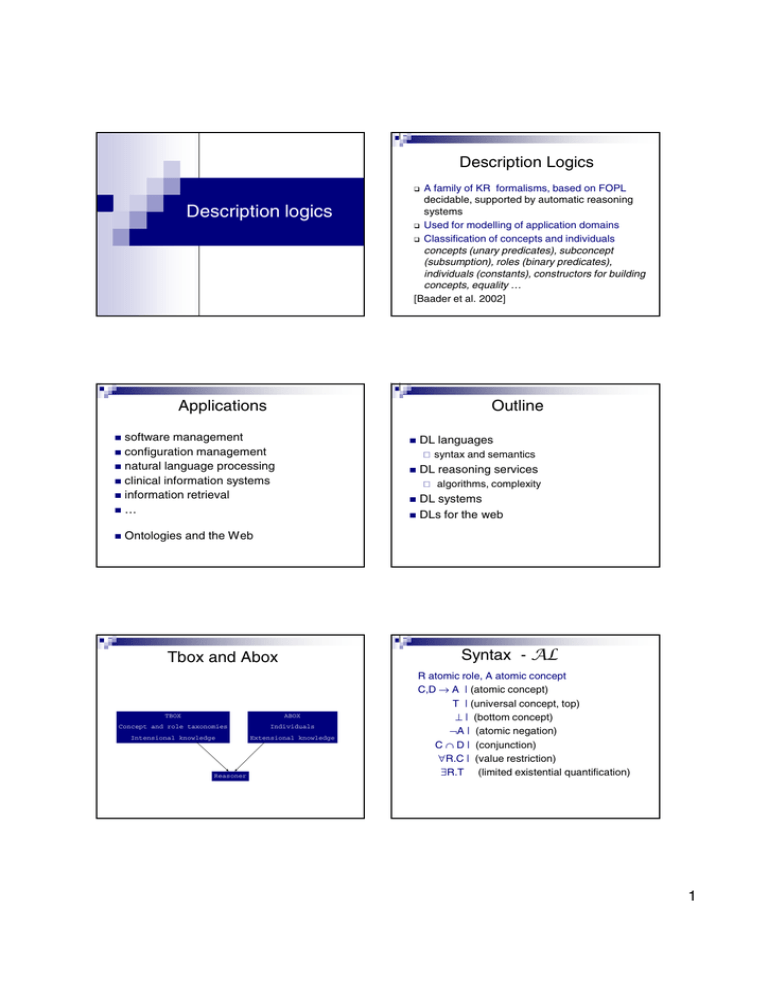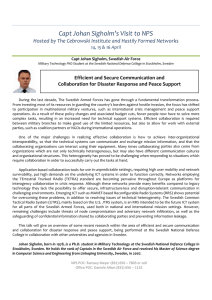Description logics Description Logics
advertisement

Description Logics
Description logics
Applications
A family of KR formalisms, based on FOPL
decidable, supported by automatic reasoning
systems
Used for modelling of application domains
Classification of concepts and individuals
concepts (unary predicates), subconcept
(subsumption), roles (binary predicates),
individuals (constants), constructors for building
concepts, equality …
[Baader et al. 2002]
Outline
software management
configuration management
natural language processing
clinical information systems
information retrieval
…
DL languages
syntax and semantics
DL reasoning services
algorithms, complexity
DL systems
DLs for the web
Ontologies and the Web
Syntax - AL
Tbox and Abox
TBOX
ABOX
Concept and role taxonomies
Individuals
Intensional knowledge
Extensional knowledge
Reasoner
R atomic role, A atomic concept
C,D → A | (atomic concept)
T | (universal concept, top)
⊥ | (bottom concept)
¬A | (atomic negation)
C ∩ D | (conjunction)
∀R.C | (value restriction)
∃R.T (limited existential quantification)
1
AL[X]
¬C (concept negation)
C
U
E
N
Q
C U D (disjunction)
∃R.C (existential quantification)
≥ n R, ≤ n R
(number restriction)
≥ n R.C, ≤ n R.C (qualified number restriction)
Example
Team
Team ∩ ≥ 10 hasMember
Team ∩ ≥ 11 hasMember
∩ ∀ hasMember.Soccer-player
AL[X]
R
I
H
F
R ∩ S (role conjunction)
R- (inverse roles)
(role hierarchies)
u1 = u2, u1 ≠ u2 (feature (dis)agreements)
S[X]
S
ALC + transitive roles
SHIQ ALC
+ transitive roles
+ role hierarchies
+ inverse roles
+ number restrictions
Tbox
Terminological axioms:
C = D (R = S)
C ⊆ D (R ⊆ S)
(disjoint C D)
An equality whose left-hand side is an
atomic concept is a definition.
A finite set of definitions T is a Tbox (or
terminology) if no symbolic name is
defined more than once.
Example Tbox
Soccer-player ⊆ T
Team ⊆ ≥ 2 hasMember
Large-Team = Team ∩ ≥ 10 hasMember
S-Team = Team ∩ ≥ 11 hasMember
∩ ∀ hasMember.Soccer-player
2
DL as sublanguage of FOPL
Team(this)
^
(∃ x1,...,x11:
hasMember(this,x1) ^ … ^ hasMember(this,x11)
^ x1 ≠ x2 ^ … ^ x10 ≠ x11)
^
(∀ x: hasMember(this,x)
Abox
Assertions about individuals:
C(a)
R(a,b)
Soccer-player(x))
Example
Individuals in the description
language
O
Ida-member(Sture)
{i1, …, ik} (one-of)
R:a (fills)
Example
(S-Team ∩ hasMember:Sture)(IDA-FF)
Knowledge base
A knowledge base is a tuple < T, A >
where T is a Tbox and A is an Abox.
3
AL (Semantics)
Example KB
An interpretation I consists of a non-empty set
∆ (the domain of the interpretation) and an
interpretation function . which assigns to
every atomic concept A a set A ⊆ ∆ and to
every atomic role R a binary relation
R ⊆ ∆ ×∆ .
I
Soccer-player ⊆ T
Team ⊆ ≥ 2 hasMember
Large-Team = Team ∩ ≥ 10 hasMember
S-Team = Team ∩ ≥ 11 hasMember
∩ ∀ hasMember.Soccer-player
I
I
I
Ida-member(Sture)
I
I
The interpretation function is extended to
concept definitions using inductive definitions.
(S-Team ∩ hasMember:Sture)(IDA-FF)
ALC (Semantics)
AL (Semantics)
C,D → A | (atomic concept)
T | (universal concept)
= ∆
T
⊥ | (bottom concept)
⊥
= Ø
¬A | (atomic negation) (¬A) = ∆ A
C ∩ D | (conjunction)
(C∩D) = C ∩D
∀R.C | (value restriction)
(∀ R.C) =
{a ∈ ∆ |∀b.(a,b) ∈R →b ∈C }
∃R.T | (limited existential (∃ R.T) = {a ∈ ∆ | ∃b.(a,b) ∈R }
quantification)
I
I
I
(¬ C) = ∆
I
I
\
C
I
I
I
I \
I
I
I
I
I
I
(C U D) = C U D
I
I
I
I
I
I
(≥ n R) = {a ∈ ∆
I
|
# {b ∈ ∆
I
|
(a,b) ∈R } ≥ n }
(≤ n R) = {a ∈ ∆
I
|
# {b ∈ ∆
I
|
(a,b) ∈R } ≤ n }
I
I
I
(∃ R.C) = {a ∈ ∆
I
I
Semantics
Individual i
i ∈∆
I
I
I
|
I
∃b ∈ ∆ : (a,b) ∈R ^ b ∈ C
I
I
I
}
Semantics
I
An interpretation . is a model for a
terminology T iff
I
Unique Name Assumption:
if i1 ≠ i2 then i1 ≠ i2
I
I
C = D for all C = D in T
I
C
I
I
⊆ DI for
C ∩D
I
I =
all a C ⊆ D in T
Ø for all (disjoint C D) in T
4
Semantics
An interpretation . is a model for a
knowledge base <T, A > iff
I
Semantics - acyclic Tbox
Bird = Animal ∩ ∀ Skin.Feather
∆ = {tweety, goofy, fea1, fur1}
Animal = {tweety, goofy}
Feather = {fea1}
Skin = {<tweety,fea1>, <goofy,fur1>}
I
. is a model for T
a ∈C
for all C(a) in A
<a ,b > ∈ R for all R(a,b) in A
I
I
I
I
I
I
I
I
I
Bird = {tweety}
I
Semantics - cyclic Tbox
QuietPerson = Person ∩ ∀ Friend.QuietPerson
( A = F(A) )
∆ = {john, sue, andrea, bill}
Person = {john, sue, andrea, bill}
Friend = {<john,sue>, <andrea,bill>, <bill,bill>}
I
I
I
QuietPerson ={john, sue}
QuietPerson ={john, sue, andrea, bill}
Semantics - cyclic Tbox
Descriptive semantics: A = F(A) is a
constraint stating that A has to be some
solution for the equation.
Not appropriate for defining concepts
Necessary and sufficient conditions for
concepts
I
I
Semantics - cyclic Tbox
Least fixpoint semantics: A = F(A) specifies that A
is to be interpreted as the smallest solution (if it
exists) for the equation.
Appropriate for inductively defining concepts
DAG = EmptyDAG U Non-Empty-DAG
Non-Empty-DAG = Node ∩ ∀ Arc.Non-Empty-DAG
Human = Mammal ∩ ∃ Parent ∩ ∀ Parent.Human
Human = ⊥
Human = Mammal ∩ ∃ Parent
∩ ∀ Parent.Human
Semantics - cyclic Tbox
Greatest fixpoint semantics: A = F(A) specifies that
A is to be interpreted as the greatest solution (if it
exists) for the equation.
Appropriate for defining concepts whose
individuals have circularly repeating structure
FoB = Blond ∩ ∃ Child.FoB
Human = Mammal ∩ ∃ Parent ∩ ∀ Parent.Human
Horse = Mammal ∩ ∃ Parent ∩ ∀ Parent.Horse
Human = Horse
5
Open world vs closed
world semantics
Databases: closed world reasoning
database instance represents one interpretation
absence of information interpreted as negative
information
“complete information”
query evaluation is finite model checking
DL: open world reasoning
Abox represents many interpretations (its models)
absence of information is lack of information
“incomplete information”
query evaluation is logical reasoning
Reasoning services
Satisfiability of concept
Subsumption between concepts
Equivalence between concepts
Disjointness of concepts
Open world vs closed
world semantics
hasChild(Jocasta, Oedipus)
hasChild(Jocasta, Polyneikes)
hasChild(Oedipus, Polyneikes)
hasChild(Polyneikes, Thersandros)
patricide(Oedipus)
¬ patricide(Thersandros)
Does it follow from the Abox that
∃hasChild.(patricide ∩ ∃hasChild. ¬ patricide)(Jocasta) ?
Reasoning services
Satisfiability of concept
C is satisfiable w.r.t. T if there is a model
is not empty.
I
of
T
such that CI
Subsumption between concepts
C is subsumed by D w.r.t. T if CI
⊆
DI for every model
of
I
T.
Classification
Equivalence between concepts
Instance checking
Realization
Retrieval
Knowledge base consistency
Reasoning services
Reduction to subsumption
C is unsatisfiable iff C is subsumed by ⊥
C and D are equivalent iff C is subsumed by D
and D is subsumed by C
C and D are disjoint iff C ∩ D is subsumed by ⊥
The statements also hold w.r.t. a Tbox.
C is equivalent to D w.r.t. T if CI
=
DI for every model
I
of
T.
Disjointness of concepts
C and D are disjoint w.r.t. T if C ∩ D
T.
I
I =
Ø for every model
I
of
Reasoning services
Reduction to unsatisfiability
C is subsumed by D iff C ∩ ¬D is unsatisfiable
C and D are equivalent iff
both (C ∩ ¬D) and (D ∩ ¬C) are
unsatisfiable
C and D are disjoint iff C ∩ D is unsatisfiable
The statements also hold w.r.t. a Tbox.
6
Tableau algorithms
To prove that C subsumes D:
Tableau algorithms
Based on constraint systems.
If C subsumes D, then it is impossible for an
individual to belong to D but not to C.
Idea: Create an individual that belongs to D
and not to C and see if it causes a
contradiction.
If always a contradiction (clash) then
subsumption is proven. Otherwise, we have
found a model that contradicts the
subsumption.
Tableau algorithms –
de Morgan rules
¬¬C
S = { x: ¬C ∩ D }
Add constraints according to a set of
propagation rules
Until clash or no constraint is applicable
Tableau algorithms – constraint
propagation rules
S
C
¬ (A ∩ B)
¬AU¬B
¬ (A U B)
¬A∩¬B
¬ (∀ R.C)
¬ (∃ R.C)
∃ R.(¬ C)
∀ R.(¬ C)
∩
{x:C1, x:C2} U S
if x: C1 ∩ C2 in S
and either x:C1 or x:C2 is not in S
S
U
{x:D} U S
if x: C1 U C2 in S and neither x:C1 or x:C2
is in S, and D = C1 or D = C2
Tableau algorithms – constraint
propagation rules
S
∀
{y:C} U S
if x: ∀ R.C in S and xRy in S and y:C is not
in S
S
∃
Example
ST: Tournament
∩ ∃ hasParticipant.Swedish
SBT: Tournament
∩ ∃ hasParticipant.(Swedish ∩ Belgian)
{xRy, y:C} U S
if x: ∃ R.C in S and y is a new variable and
there is no z such that both xRz and z:C
are in S
7
Example 1
SBT => ST?
S = { x:
¬(Tournament ∩ ∃ hasParticipant.Swedish)
∩ (Tournament
∩ ∃ hasParticipant.(Swedish ∩ Belgian))
}
Example 1
S = { x:
(¬Tournament
U ∀ hasParticipant.¬ Swedish)
∩ (Tournament
∩ ∃ hasParticipant.(Swedish ∩ Belgian))
}
Example 1
∩-rule:
S={
x: (¬Tournament
U ∀ hasParticipant.¬ Swedish)
∩ (Tournament
∩ ∃ hasParticipant.(Swedish ∩ Belgian)),
x: ¬Tournament
U ∀ hasParticipant.¬ Swedish,
x: Tournament,
x: ∃ hasParticipant.(Swedish ∩ Belgian)
}
Example 1
∃ -rule:
S={
x: (¬Tournament U ∀ hasParticipant.¬ Swedish)
∩ (Tournament
∩ ∃ hasParticipant.(Swedish ∩ Belgian)),
x: ¬Tournament
U ∀ hasParticipant.¬ Swedish,
x: Tournament,
x: ∃ hasParticipant.(Swedish ∩ Belgian),
x hasParticipant y, y: (Swedish ∩ Belgian)
}
Example 1
∩-rule:
(¬Tournament U ∀ hasParticipant.¬ Swedish)
∩ (Tournament
∩ ∃ hasParticipant.(Swedish ∩ Belgian)),
x: ¬Tournament U ∀ hasParticipant.¬ Swedish,
x: Tournament,
x: ∃ hasParticipant.(Swedish ∩ Belgian),
x hasParticipant y, y: (Swedish ∩ Belgian),
y: Swedish, y: Belgian
}
S= {x:
Example 1
U-rule, choice 1
S = { x: (¬Tournament U ∀ hasParticipant.¬ Swedish)
∩ (Tournament
∩ ∃ hasParticipant.(Swedish ∩ Belgian)),
x: ¬Tournament U ∀ hasParticipant.¬ Swedish,
x: Tournament,
x: ∃ hasParticipant.(Swedish ∩ Belgian),
x hasParticipant y, y: (Swedish ∩ Belgian),
y: Swedish, y: Belgian,
x: ¬Tournament
}
clash
8
Example 1
U-rule, choice 2
S = {x: (¬Tournament U ∀ hasParticipant.¬ Swedish)
∩ (Tournament
∩ ∃ hasParticipant.(Swedish ∩ Belgian)),
x: ¬Tournament U ∀ hasParticipant.¬ Swedish,
x: Tournament,
x: ∃ hasParticipant.(Swedish ∩ Belgian),
x hasParticipant y, y: (Swedish ∩ Belgian),
y: Swedish, y: Belgian,
x: ∀ hasParticipant.¬ Swedish
}
Example 2
ST => SBT?
S = { x:
¬ (Tournament
∩ ∃ hasParticipant.(Swedish ∩ Belgian))
∩ (Tournament ∩ ∃ hasParticipant.Swedish)
}
Example 2
∩-rule
S={
x: (¬Tournament
U ∀ hasParticipant.(¬ Swedish U ¬ Belgian))
∩ (Tournament ∩ ∃ hasParticipant.Swedish),
x: (¬Tournament
U ∀ hasParticipant.(¬ Swedish U ¬ Belgian)),
x: Tournament,
x: ∃ hasParticipant.Swedish
}
Example 1
choice 2 – continued
∀-rule
S={
x: (¬Tournament U ∀ hasParticipant.¬ Swedish)
∩ (Tournament ∩ ∃ hasParticipant.(Swedish ∩ Belgian)),
x: ¬Tournament U ∀ hasParticipant.¬ Swedish,
x: Tournament,
x: ∃ hasParticipant.(Swedish ∩ Belgian),
x hasParticipant y, y: (Swedish ∩ Belgian),
y: Swedish, y: Belgian,
x: ∀ hasParticipant.¬ Swedish,
y: ¬ Swedish
}
clash
Example 2
S = { x:
(¬Tournament
U ∀ hasParticipant.(¬ Swedish U ¬ Belgian))
∩ (Tournament ∩ ∃ hasParticipant.Swedish)
}
Example 2
∃ -rule
S={
x: (¬Tournament
U ∀ hasParticipant.(¬ Swedish U ¬ Belgian))
∩ (Tournament ∩ ∃ hasParticipant.Swedish),
x: (¬Tournament
U ∀ hasParticipant.(¬ Swedish U ¬ Belgian)),
x: Tournament,
x: ∃ hasParticipant.Swedish,
x hasParticipant y, y: Swedish
}
9
Example 2
U –rule, choice 1
S={
x: (¬Tournament
U ∀ hasParticipant.(¬ Swedish U ¬ Belgian))
∩ (Tournament ∩ ∃ hasParticipant.Swedish),
x: (¬Tournament
U ∀ hasParticipant.(¬ Swedish U ¬ Belgian)),
x: Tournament,
x: ∃ hasParticipant.Swedish,
x hasParticipant y, y: Swedish,
x: ¬Tournament
}
clash
Example 2
choice 2 continued
∀–rule
S={
x: (¬Tournament
U ∀ hasParticipant.(¬ Swedish U ¬ Belgian))
∩ (Tournament ∩ ∃ hasParticipant.Swedish),
x: (¬Tournament
U ∀ hasParticipant.(¬ Swedish U ¬ Belgian)),
x: Tournament,
x: ∃ hasParticipant.Swedish,
x hasParticipant y, y: Swedish,
x: ∀ hasParticipant.(¬ Swedish U ¬ Belgian),
y: (¬ Swedish U ¬ Belgian)
}
Example 2
choice 2 continued
U–rule, choice 2.2
S={
x: (¬Tournament
U ∀ hasParticipant.(¬ Swedish U ¬ Belgian))
∩ (Tournament ∩ ∃ hasParticipant.Swedish),
x: (¬Tournament
U ∀ hasParticipant.(¬ Swedish U ¬ Belgian)),
x: Tournament,
x: ∃ hasParticipant.Swedish,
x hasParticipant y, y: Swedish,
x: ∀ hasParticipant.(¬ Swedish U ¬ Belgian),
y: (¬ Swedish U ¬ Belgian),
y: ¬ Belgian
}
ok, model
Example 2
U –rule, choice 2
S={
x: (¬Tournament
U ∀ hasParticipant.(¬ Swedish U ¬ Belgian))
∩ (Tournament ∩ ∃ hasParticipant.Swedish),
x: (¬Tournament
U ∀ hasParticipant.(¬ Swedish U ¬ Belgian)),
x: Tournament,
x: ∃ hasParticipant.Swedish,
x hasParticipant y, y: Swedish,
x: ∀ hasParticipant.(¬ Swedish U ¬ Belgian)
}
Example 2
choice 2 continued
U–rule, choice 2.1
S={
x: (¬Tournament
U ∀ hasParticipant.(¬ Swedish U ¬ Belgian))
∩ (Tournament ∩ ∃ hasParticipant.Swedish),
x: (¬Tournament
U ∀ hasParticipant.(¬ Swedish U ¬ Belgian)),
x: Tournament,
x: ∃ hasParticipant.Swedish,
x hasParticipant y, y: Swedish,
x: ∀ hasParticipant.(¬ Swedish U ¬ Belgian),
y: (¬ Swedish U ¬ Belgian),
y: ¬ Swedish
}
clash
Complexity - languages
Overview available via the DL home page at
http://dl.kr.org
Example tractable language:
A, T,⊥ , ¬A, C ∩ D, ∀R.C, ≥ n R, ≤ n R
Reasons for intractability:
choices, e.g. C U D
exponential size models,
e.g interplay universal and existential quantification
Reasons for undecidability:
e.g. role-value maps R=S
10
Systems
undecidable KL-ONE
Systems
Loom
NIKL
ExpTime
PSpace
FaCT,
Investigation
DLP, RACER
CRACK, KRIS
Of complexity
NP
starts
Overview available via the DL home page
at http://dl.kr.org
Current systems include: CEL, Cerebra
Enginer, FaCT++, fuzzyDL, HermiT,
KAON2, MSPASS, Pellet, QuOnto,
RacerPro, SHER
CLASSIC
PTime
Late
1980s
Early
1990s
Mid
1990s
Late
1990s
Extensions
Time
Defaults
Part-of
Knowledge and belief
Uncertainty (fuzzy, probabilistic)
OWL
OWL-Lite, OWL-DL, OWL-Full: increasing
expressivity
A legal OWL-Lite ontology is a legal OWL-DL
ontology is a legal OWL-Full ontology
OWL-DL: expressive description logic, decidable
XML-based
RDF-based (OWL-Full is extension of RDF, OWLLite and OWL-DL are extensions of a restriction of
RDF)
11
OWL-Lite
Class, subClassOf, equivalentClass
intersectionOf (only named classes and restrictions)
Property, subPropertyOf, equivalentProperty
domain, range (global restrictions)
inverseOf, TransitiveProperty (*), SymmetricProperty,
FunctionalProperty, InverseFunctionalProperty
allValuesFrom, someValuesFrom (local restrictions)
minCardinality, maxCardinality (only 0/1)
Individual, sameAs, differentFrom, AllDifferent
OWL-DL
Type separation (class cannot also be individual or property, property
cannot be also class or individual), Separation between DatatypeProperties
and ObjectProperties
Class –complex classes, subClassOf, equivalentClass, disjointWith
intersectionOf, unionOf, complementOf
Property, subPropertyOf, equivalentProperty
domain, range (global restrictions)
inverseOf, TransitiveProperty (*), SymmetricProperty, FunctionalProperty,
InverseFunctionalProperty
allValuesFrom, someValuesFrom (local restrictions), oneOf, hasValue
minCardinality, maxCardinality
Individual, sameAs, differentFrom, AllDifferent
(*) restricted
(*) restricted
References
Baader, Calvanese, McGuinness, Nardi, PatelSchneider. The Description Logic Handbook.
Cambridge University Press, 2003.
Donini, Lenzerini, Nardi, Schaerf, Reasoning in
description logics. Principles of knowledge
representation. CSLI publications. pp 191-236.
1996.
dl.kr.org
www.daml.org
www.w3.org (owl)
12






